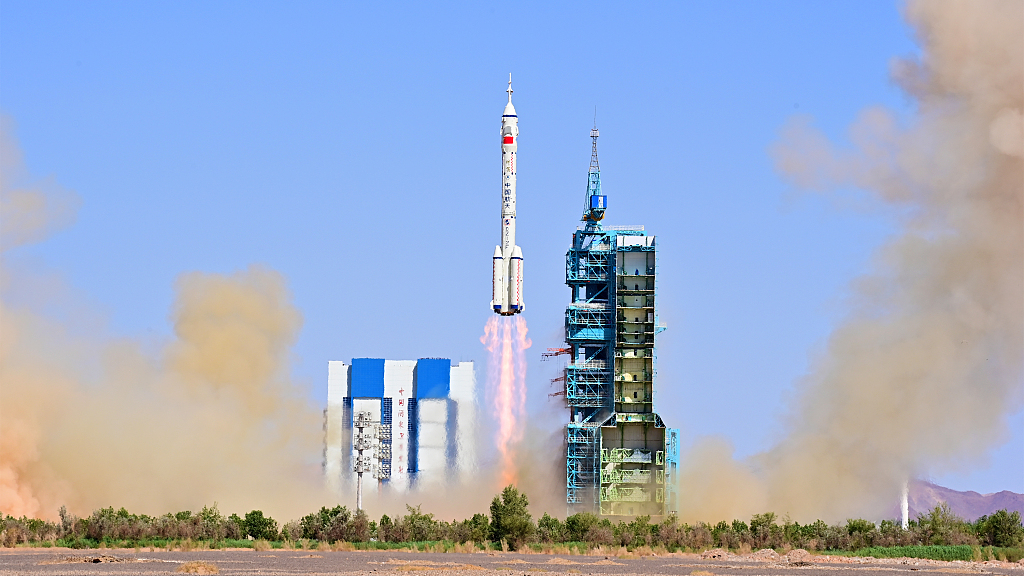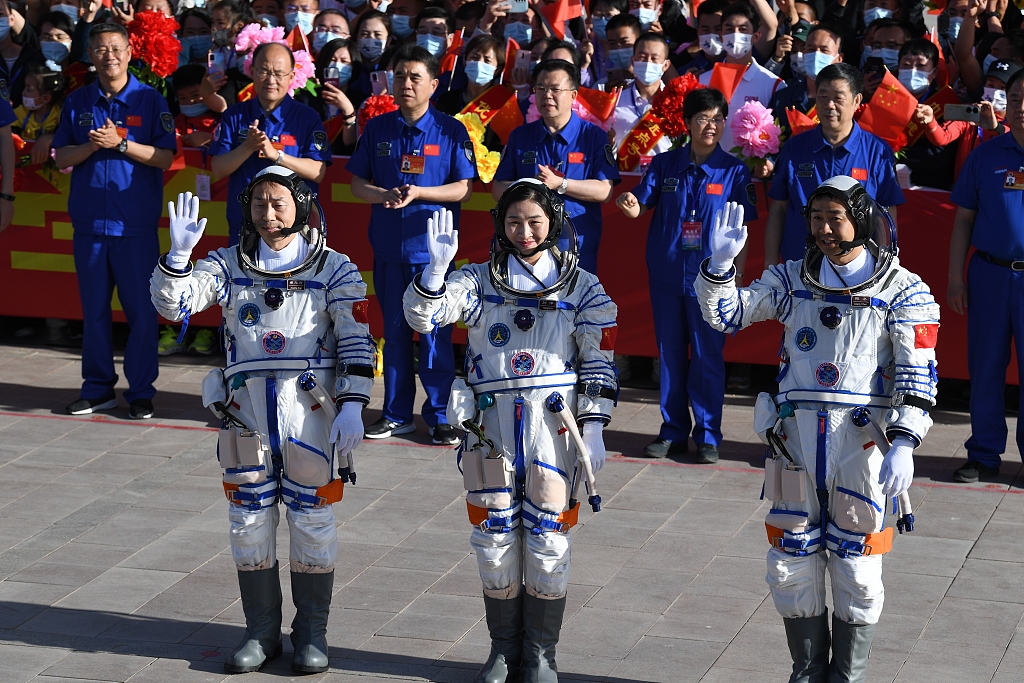
The Shenzhou-14 manned spacecraft is launched from the Jiuquan Satellite Launch Center in northwest China's Gansu Province, June 5, 2022. /Xinhua
The Shenzhou-14 manned spacecraft is launched from the Jiuquan Satellite Launch Center in northwest China's Gansu Province, June 5, 2022. /Xinhua
Editor's note: Yang Yuguang is vice chair of the Space Transportation Committee of the International Astronautical Federation. The article reflects the author's opinions and not necessarily the views of CGTN.
China has successfully launched the Shenzhou-14, a crewed spaceship with three astronauts Chen Dong, Cai Xuzhe and Liu Yang onboard. It's the first manned mission during the construction phase of China's Tiangong space station and the most important crewed mission in this phase.
Concerning the crew transportation, the Shenzhou-14 mission is very similar to Shenzhou-13, both of which stayed or will stay in outer space for about half a year, docked to the Earth-facing docking port of the Tianhe-1 core module. Unlike those spacecrafts approaching the station from the front or the rear direction, the Shenzhou-14 will dock to its nadir port, which is more difficult because the relative positions of both spacecrafts are essentially unstable. Thanks to the Shenzhou-12 crew, they partially tested this procedure when they left the station and it has already become very practical for the country.
Except for those features similar to Shenzhou-12/13 missions, the role of Shenzhou-14 is remarkably different. For the Shenzhou-12 and Shenzhou-13 crews, the most important tasks were to test the technologies, which were critical and necessary for the construction and operations of the Tiangong Space Station. But for Shenzhou-14 crew, the most important task is to attend the whole construction procedures of Tiangong.
In July, about one month after the Shenzhou-14 mission, China will launch the Wentian lab module from the Wenchang spacecraft launch site. The module and its launch vehicle, Long March-5B Y3 rocket has already arrived in Wenchang and is performing tests. The launch of this Wentian module will be another critical step for Tiangong construction.
Although the rendezvous and docking technologies of China have been practical, it is a risky part of the whole flight. To ensure safe docking, we must have both automatic and manual docking capabilities and each can be recognized as backup measures of the other one.
When the Wentian module is approaching the Tiangong space station, the ground team and Shenzhou-14 crew will monitor the whole process. If anything goes wrong to the automatic docking system, the Shenzhou-14 crew will switch to a manual docking mode and accomplish the docking. As the Wentian module is an unmanned vehicle, the manual docking must be conducted with remote control. That is, there is a control panel inside Tianhe-1, and Shenzhou-14 crew will use handles and buttons on this panel to control the movements of the Wentian. Therefore, with attendance of the Shenzhou-14 crew, the docking itself can be more reliable. Also thanks to the Shenzhou-13 crew, this technology has been tested by remotely controlling the Tianzhou-2 cargoship to manually dock to the station.

Astronauts Cai Xuzhe (L), Liu Yang (C) and Chen Dong wave during a see-off ceremony for astronauts of the Shenzhou-14 manned space mission in Jiuquan Satellite Launch Center in northwest China's Gansu Province, June 5, 2022. /Xinhua
Astronauts Cai Xuzhe (L), Liu Yang (C) and Chen Dong wave during a see-off ceremony for astronauts of the Shenzhou-14 manned space mission in Jiuquan Satellite Launch Center in northwest China's Gansu Province, June 5, 2022. /Xinhua
After docking, the Wentian and Tianhe-1 modules will form the "I-shaped" form temporally. The Shenzhou-14 crew will enter this module, install devices and perform tests. Then the module will be transferred from the front docking port to one of the side berthing ports, which will be its final and permanent position.
We will use trans-position mechanism as the primary measure to achieve this goal, although China hasn't tested this technology in orbit before. Therefore, if anything goes wrong with it, we will use the 10-meter robotic arm to grasp the Wentian and transfer it. If this happens, the Shenzhou-14 crew will monitor the whole process and in certain circumstance, they can even control the robotic arm from the station.
Although the Tianhe-1 core module also has racks dedicated for scientific research, the major role of this module is to act as the control center for the whole station, only 3-4 racks are purely for scientific research purposes. In the Wentian and Mengtian modules, there will have 14 racks for scientific research. We can imagine that the scope, quantity and scientific experiments will increase when Shenzhou-14 crew resident in the station, which is another challenging task for them.
Like those performed during the Shenzhou-12 and Shenzhou-13 missions, extravehicular activities (EVAs) are an important part of the Shenzhou-14 mission. There are numerous devices to be mounted or adjusted outside the station. But unlike the former missions, the Shenzhou-14 crew will conduct EVAs from the main airlock of the station. This airlock is located in the Wentian module and airlock of Tianhe-1 will act as a backup in the future.
In the Mengtian module, there will also have an airlock, but this is to transfer goods between the cabin and outer space. Until today, EVAs are still risky tasks for all space capable nations, and the lifespan of EVA spacesuits also has a limit. Using the cargo airlock will not only save resources, but ensure the safety of astronauts.
When the tasks of the Shenzhou-14 crew come to an end, they will not leave until the arrival of the Shenzhou-15 crew. At that moment, we will have six Chinese astronauts in orbit, and making history again. This can bring high efficiency for the roll over of different expedition teams. The Shenzhou-14 crew will tell the Shenzhou-15 crew everything face-to-face, including the progress of the experiments, and status of all critical systems of the station. Since we have an independent environmental control and life support system in the Wentian module, and another three private bedrooms for astronauts, this task will be done without difficulty.
(If you want to contribute and have specific expertise, please contact us at opinions@cgtn.com. Follow @thouse_opinions on Twitter to discover the latest commentaries in the CGTN Opinion Section.)

